|
CANON 50MM f/1.2 RANGEFINDER LENS 1956-1967
|
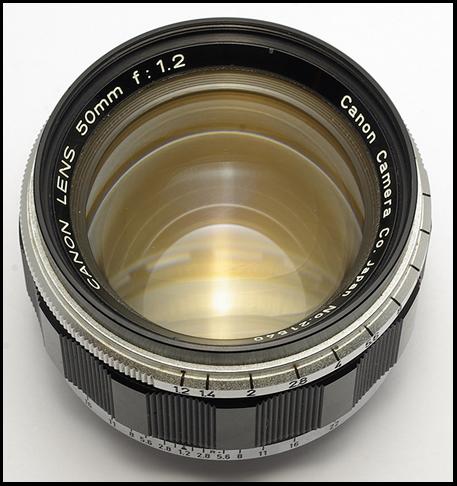 |
| Image courtesy of www.russianarsenal.com |
|
|
Introduced in September of 1956 by Canon, the 50mm f/1.2 lens was the fastest mass market lens available in Leica Thread Mount at that time. Canon advertised that the lens "incorporates rare-glass elements, permitting its aberration-free performance at all stops."
The lens is comprised of 7 elements in 5* groups, has click stops from f/1.2 to f/22, the aperture is comprised of 11 blades, utilizes 55mm filters and a 57mm lens cap, has a minimum focusing distance of 3.5 feet and weighs in at 11.4 ounces.
There are two versions of the 50mm f/1.2 lens, with the difference being merely cosmetic - the first version has "CANON CAMERA CO. Japan" imprinted around the rim, while version two has "CANON CAMERA CO., Inc. LENS MADE IN JAPAN" imprinted. According to Canon Rangefinder collector and expert, Peter Kitchingman and as written in his Canon Rangefinder book, version one was produced from 1956-1960, while version two was produced 1961-1967. Peter has confirmed that 43,675 of the 50mm f/1.2 lenses were produced - with about 24,000 being of version one and the remaining being of version two. Serial numbers run from 10050 to 56440, again according to Kitchingman.
Version one came with a 57mm satin chrome lens cap and a 40mm satin chrome rear cap, while version two came with a 57mm black plastic lens cap and a 40mm black plastic rear cap.
While the 50mm f/1.2 lens had a standard black and satin chrome finish, a small amount of "black" versions of this lens were produced as an option for purchasers of the "all-black" Canon Rangefinder camera bodies. The aperture ring and distance scale was finished in black rather than the normal chrome finish. Scroll down the page for an image of this variant. You can read more about the "black" version by clicking here which will send you to the "Rangefinder Forum."
*The following Canon publication,
states the 50mm f/1.2 as having 7 elements in 4 groups, while the Canon Camera Museum states the lens as being 7 elements in 5 groups !
|
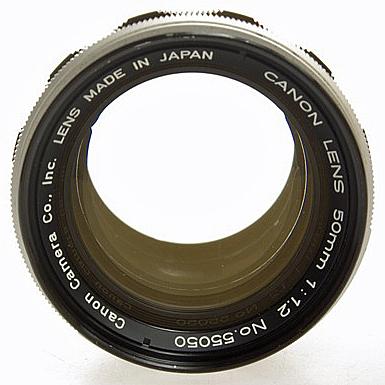 |
| Version Two of the 50mm f/1.2 Lens |
|
|
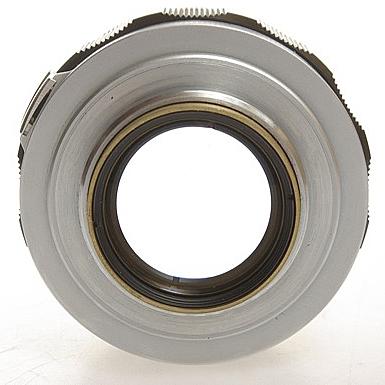 |
| Version Two of the 50mm f/1.2 Lens |
|
|
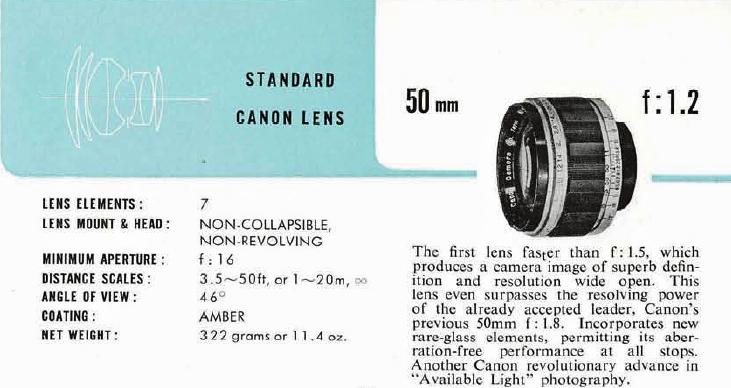 |
| 1958 Catalogue Entry |
|
|
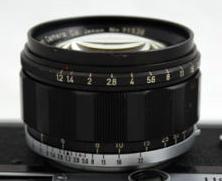 |
| "Black" version |
|
|
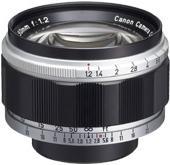 |
| "Normal" black and chrome version |
|
|
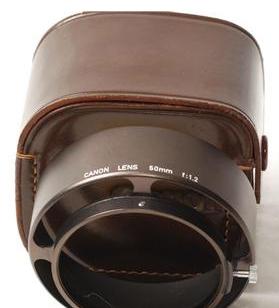 |
| The Canon 50mm f/1.2 Dedicated Lens Hood & Case |
|
|
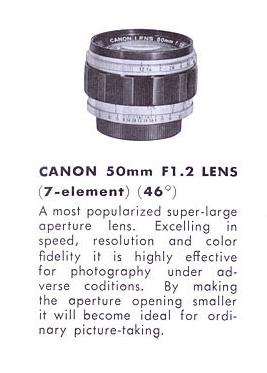 |
| 1963 Catalogue Entry |
|
|
Unlike most other classic lenses, the Canon 50mm f/1.2 lens garners very different and opposing opinions as to its quality. While many users have reported unacceptable softness, significant flare and poor contrast, there is a large camp of users who feel the lens is, at least, adequately sharp for a 1.2 speed lens and produces many unique and lovely qualities making it an exciting lens to use. There are many examples of image quality from this lens on the internet and many examples where sharpness does appear to be more than acceptable.
Many who enjoy this lens suggest that this lens needs to be properly calibrated to a given camera to bring out the best of its ability to render sharpness. While this is true of almost any classic RF lens of this speed, and its very thin DOF, users have reported fairly significant improvements in quality after proper adjustment.
Additionally, I have noticed in researching this lens, that people who use this lens on Leica M cameras seem to have higher praise for this lens than people using other camera bodies. This could be a function of the camera's rangefinder focusing accuracy and/or if the camera is properly calibrated for best focus to begin with. As far as focusing accuracy, the Leica M3 has the best "Effective Base Length" of any RF camera - far execeeding the Canon RF bodies and even the LTM Leicas. The better the EBL, the more accurate focusing capability is. See Cameraquests article and camera rankings for EBL here: http://cameraquest.com/leica.htm
There is also speculation that given some camera bodies have a better light baffling system that reduces stray light between the lens and the film/sensor gate, that this could also be influencing some users opinion of this lens as it relates to contrast and flare. Lets not forget that this lens is one the first "super-speed" lenses, and is single coated - so expectations for a flare free performance, or high contrast is a bit unreasonable. And to compare this lens to the Noctilux (the original f/1.2 or the later F/1.0), which many want to do, is also not a fair comparison given the 'Noct was first produced 10 years later and utilized aspherical elements, not to mention the 10 fold difference in price between the two lenses.
The Canon 50mm f/1.2 remains for many, an affordable super speed lens in a conveninet mount which has a unique, optical signature.
BOKEH
The main reason people acquire this lens is for its bokeh. But again, people are deciseively split in their opinions on the quality of the bokeh produced. Many love it, many don't. You be the judge - see some images below.
PRICING
Over the last decade, this lens has been highly sought after for a few specific reasons:
1. As a f/1.2 RF lens, its less expensive compared to the other super fast options on the market
2. Its optical signature and bokeh
3. Its new life on digital cameras including 4/3rds which makes it the equivalent to a super speed 'telephoto' lens
Depending on condition and the supply and demand at any given point, these lenses typically sell in the $ 275-450 range on ebay.com for an example in excellent condition. The all black version can run up to $ 750. The dedicated lens hood is quite scarce and also highly sought after, commanding as much as $ 125 and sometimes even more.
CANON 50mm f0.95
The f/0.95 lens arrived on the scene in 1961, and was the fastest traditional camera lens yet available. It also replaced the f/1.2 Canon as the fastest lens in the Canon family. While many on the internet claim it has the same optical formula as the 50mm f/1.2, it is actually slightly different. The rear most element on the f/0.95 lens is thicker than in the f/1.2 lens, and the glass types are different in elements # 2 and # 3 (supported by optical layouts from a Canon publication). Peter Kitchingman has also confirmed that elements 4,5,6 and 7 differ in curvatures between the two lenses. Below you will find the optical layouts for each lens:
|
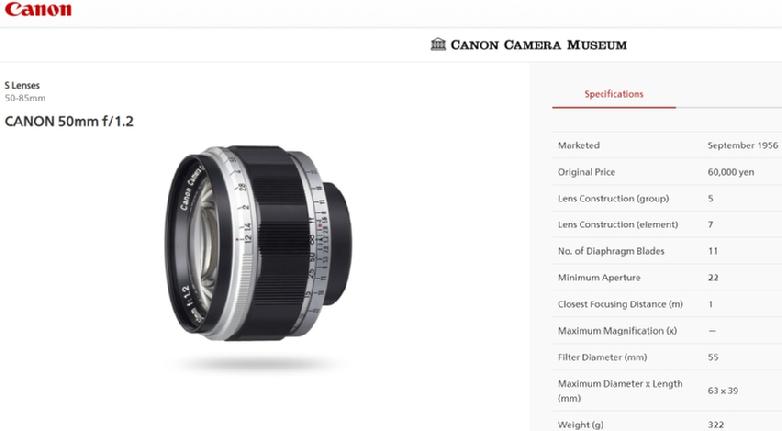 |
| Courtesy of The Canon Camera Museum |
|
|
|
Images captured with the CANON 50mm f/1.2 LENS
|
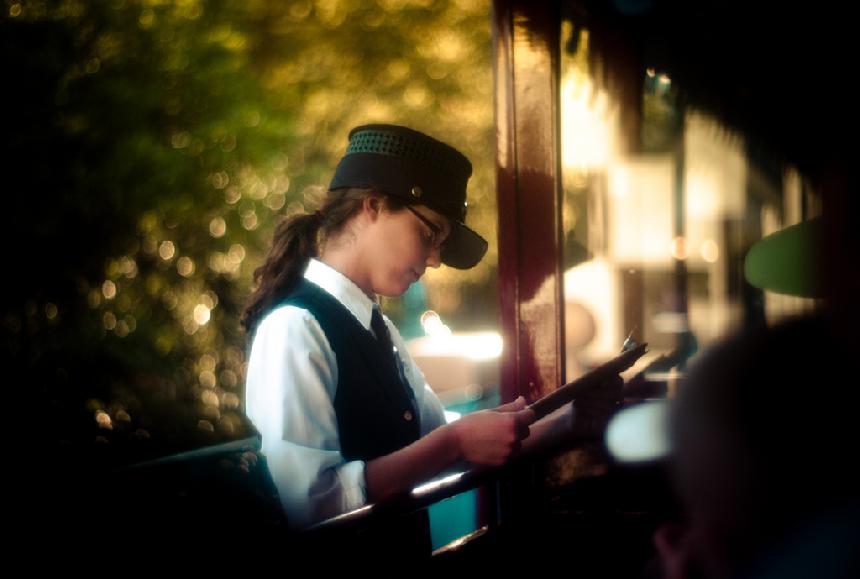 |
| Image by Ivan Jurado |
|
|
 |
| Image By Liam Strain, Streetlevel Photography |
|
|
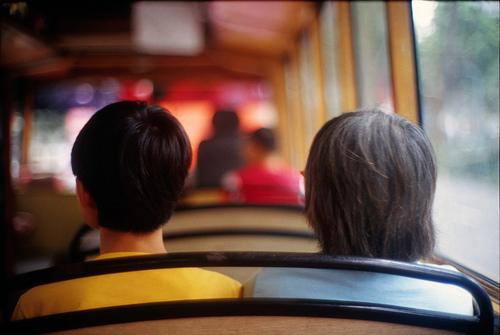 |
| Image by Gary Wang |
|
|
 |
| Image by Antti Sivén |
|
|
 |
| Image by Scott Everett. All Rights Reserved |
|
|
|